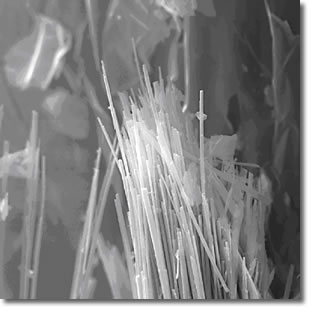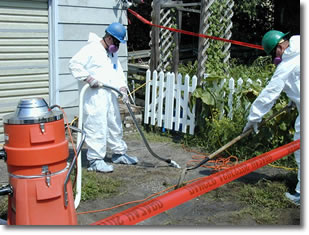

 |
 |
 |
|
 |
|
|||||||||||||||||||||||||||||||||||||||
 |
| Waste ("stoner") rock at the former Western Mineral Products site. Circled are grains of pure Libby Asbestos still visible more than a decade after the plant closed. |
In NE Minneapolis, people used the waste rock in their yards, gardens,
driveways,
barbeques, and other construction projects. Children from the neighborhood
also played on piles of “crush rock.”
Go to > top.
 Asbestos
is a mineral fiber that is very toxic if inhaled. It has been known for
many years that workers exposed to asbestos suffer from asbestos-related
diseases. These diseases generally are not diagnosed until 20-30 years
after coming into contact with (exposure to) asbestos.
Asbestos
is a mineral fiber that is very toxic if inhaled. It has been known for
many years that workers exposed to asbestos suffer from asbestos-related
diseases. These diseases generally are not diagnosed until 20-30 years
after coming into contact with (exposure to) asbestos.
Asbestos exposure can cause a type of permanent lung damage known as asbestosis, which causes shortness of breath and increases the risk of serious lung infections. Asbestos can also cause lung cancer, and a rare type of cancer known as mesothelioma, which affects the lining around the lungs and abdomen.
One of the most common effects seen on chest x-rays are changes in the lining of the lungs, called pleural plaques and pleural thickening. In some cases, these changes may cause difficulty breathing.
Individual health risk depends on many factors, including how much and how long a person is exposed, and their age, occupation, smoking and health history. Residents concerned about health problems associated with asbestos exposure should consult their physician.
Go to > top.
Health studies have shown an increase in asbestos-related disease among people who have worked in vermiculite mines and processing facilities. There have also been reports of asbestos-related disease among family member of workers, as well as residents of the surrounding community.
To learn more about exposures to the community and possible health risks, MDH investigators have interviewed residents living near the site. Former residents and owners of contaminated properties were also interviewed. This information, together with additional studies from Libby, Montana, has helped to identify the extent of asbestos exposure to workers and the community.
In the spring of 2003, NMCVI participants received letters describing
ways that people were exposed, and giving health recommendations.
NMCVI Preliminary Report: September 2004 (PDF: 191KB/4 pages)
NMCVI Final Report, November 2005 (PDF: 5421KB/70 pages)
Fact Sheet: Community Concerns about Cancer in Northeast Minneapolis (PDF: 120KB/2 pages)
From the Minnesota Cancer Surveillance System at Minnesota Department of Health
Go to > top.
 Go
to > top.
Go
to > top.
Clean-up of the former Western Mineral Products site was completed in November 2001. Since the fall of 2000, the US EPA has been removing visible Libby asbestos in yards, driveways and alleys at no cost to the homeowner. About 260 residential properties have been identified for clean-up.
Go to > top.
Care should be taken to prevent future exposures: 1) While most of the visible waste has been removed, there will always be the possibility of it being uncovered during construction, road improvements or landscaping. 2)Vermiculite insulation indoors may release fibers if disturbed. The best advice is to leave it alone or, if necessary, have it removed by a licensed professional.
There is still much to be learned about asbestos-related disease and
ways to treat it. MDH will continue to develop resource materials for
the health care providers.
MDH will use the results of the NMCVI to determine if additional health
follow-up studies are needed.
Go to > top.
Health Consultations
Site
Background, 2001 (PDF: 3385KB/46 pages)
Exposure
Assessment, 2003 (PDF: 1250KB/57 pages)
Northeast Minneapolis Community Vermiculite Investigation Report, 2005 (PDF: 5421KB/70 pages) - Full document
Northeast Minneapolis Community Vermiculite Investigation Report, 2005 (PDF: 439KB/39 pages) - Text
Northeast Minneapolis Community Vermiculite Investigation Report, 2005 (PDF: 157KB/19 pages) - Tables
Northeast Minneapolis Community Vermiculite Investigation Report, 2005 (PDF: 2387KB/12 pages) - Figures and Appendix
Go to > top
Tannie Eshenaur – 651-201-4897
Go to > top.
For more information about this page, please contact us at health.hazard@state.mn.us call 651-201-4897, or toll-free 1-800-657-3908 and press "4" to leave a message.
The Final Northeast Minneapolis Community Vermiculite Investigation Report, 2005 is now available.
Download full report (PDF:
5421KB/70 pages)
Download report in segments
See news release
Information about vermiculite, floor tile, transite air
ducts and mold for the regulated asbestos industry and others more »
(PDF:
105KB/2 pages)

![]() To view the PDF files, you will need
Adobe Acrobat Reader (free download from Adobe's Web site).
To view the PDF files, you will need
Adobe Acrobat Reader (free download from Adobe's Web site).